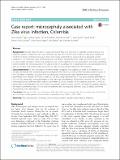Case report: microcephaly associated with Zika virus infection, Colombia
Author(s)
Mattar, Salim; Ojeda, Carolina; Arboleda, Janna; Arrieta, German; Bosch, Irene; Botia, Ingrid; Alvis-Guzman, Nelson; Perez-Yepes, Carlos; Gerhke, Lee; Montero, German; ... Show more Show less
Download12879_2017_Article_2522.pdf (646.5Kb)
PUBLISHER_CC
Publisher with Creative Commons License
Creative Commons Attribution
Terms of use
Metadata
Show full item recordAbstract
Background
Recently there has been a large outbreak of Zika virus infections in Colombia, South America. The epidemic began in September 2015 and continued to April 2017, for the total number of Zika cases reported of 107,870. For those confirmed Zika cases, there were nearly 20,000 (18.5%) suspected to be pregnant women, resulting in 157 confirmed cases of microcephaly in newborns reported by their health government agency. There is a clear under-estimation of the total number of cases and in addition no prior publications have been published to demonstrate the clinical aspects of the Zika infection in Colombia. We characterized one Zika presentation to be able to compare and contrast with other cases of Zika infection already reported in the literature.
Case presentation
In this case report, we demonstrate congenital microcephaly at week 19 of gestation in a 34-year-old mother who showed symptoms compatible with Zika virus infection from Sincelejo, State of Sucre, in the Colombian Caribbean. Zika virus RNA was detected in the placenta using real-time reverse transcriptase polymerase chain reaction (RT-PCR). At week 25, the fetus weigh estimate was 770 g, had a cephalic perimeter of 20.2 cm (5th percentile), ventriculomegaly on the right side and dilatation of the fourth ventricle. At week 32, the microcephaly was confirmed with a cephalic perimeter of 22 cm, dilatation of the posterior atrium to 13 mm, an abnormally small cerebellum (29 mm), and an augmented cisterna magna. At birth (39 weeks by cesarean section), the head circumference was 27.5 cm, and computerized axial tomography (Siemens Corp, 32-slides) confirmed microcephaly with calcifications.
Conclusion
We report a first case of maternal Zika virus infection associated with fetal microcephaly in Colombia and confirmed similar presentation to those observed previous in Brazil, 2015–2016.
Date issued
2017-06Department
Institute for Medical Engineering and ScienceJournal
BMC Infectious Diseases
Publisher
Biomed Central Ltd
Citation
Mattar, Salim; Ojeda, Carolina; Arboleda, Janna; Arrieta, German; Bosch, Irene and Botia, Ingrid. "Case report: microcephaly associated with Zika virus infection, Colombia." BMC Infectious Diseases 17 (June 2017: 423) © 2017 The Author(s)
Version: Final published version
ISSN
1471-2334